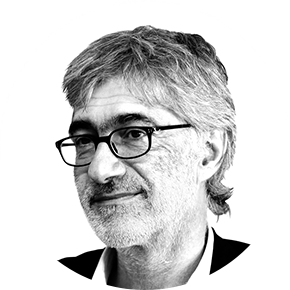Salvatore Iaconesi e Oriana Persico stanno lavorando con gli studenti dell'ISIA a Firenze. Una vicenda straordinaria. Che ha già cominciato a far discutere. E la conversazione continua qui. Il racconto più approfondito si troverà domenica prossima su Nòva.
C'è tanta attenzione per l'avvio dell'esperimento di Near Future Design del sistema educativo che stiamo avviando ad ISIA di Firenze. E molte discussioni interessanti ed importanti.
Una che mi sta molto a cuore la potete vedere qui, su Facebook:
Juan Carlos De Martin ha, forse, colto un punto di vista molto importante. Che val la pena esplorare.
Lo sintetizzo con il suo primo commento:
Se io fossi un neoliberista, commenterei soddisfatto: "Visto che facciamo bene a tagliare i fondi all'istruzione pubblica?"
e con un commento un po' più in basso:
La storia insegna che la retorica del "tutto deve cambiare" nel 2014 è, paradossalmente, reazionaria.
Questo punto di vista mi interessa moltissimo, perché evidenzia una trappola in cui non si deve cadere.
Questa azione non riguarda il "cambiare tutto". Come non riguarda il lamentarsi, il populismo, la fuga.
Questa azione riguarda il desiderio, l'immaginario, l'accesso, il linguaggio e, di conseguenza, la nostra possibilità di percepire, pensare e, quindi, di costruire.
Siamo da troppo tempo in uno stato di emergenza continua.
Passiamo da una emergenza all'altra, senza il tempo e il modo di immaginare – e quindi di desiderare e costruire – un mondo più giusto, inclusivo, aperto, critico, civico, civile, etico. In cui valgano contemporaneamente molte economie diverse, capaci di coesistere in maniera ecosistemica.
In un mondo sempre più codificato (da altri) la salute, l'educazione, l'ambiente, le relazioni stanno diventando sempre più cose che si "comprano" (nei vari modi possibili nell'era digitale e dei social network), invece di cose che si "fanno".
È forse una crisi dell'immaginario e del desiderio, piuttosto che una crisi finanziaria.
L'azione ad ISIA è una performance. Come in tutte le performance, lo scopo è quello di creare uno stato di sospensione. Una condizione in cui sospendere per un istante la possibilità di discernere tra possibile e impossibile, permesso e vietato, vero e falso, concesso e negato. E di sfruttare questo stato di sospensione per spostare un po' più in là la nostra percezione di "ciò che è possibile".
Per acquisire un nuovo linguaggio – un nuovo strumento – con cui pensare e con cui costruire il mondo.
Come in tutte le performance, la gran parte del lavoro lo fa il pubblico. Nella performance non esiste pubblico "passivo". Il "credere" alla performance, in quel che accade, è operazione attiva, emergente: si tratta di riconoscere un nuovo linguaggio e, quindi, una nuova possibilità di "mondo". Si tratta di assumere una nuova sensibilità, che include una nuova percezione del mondo, in cui anche la performance è possibile.
Si tratta di desiderare che la performance sia vera. E, quindi, di renderla vera, partecipando all'adozione di un linguaggio.
Tornando ad ISIA: questo è, in altre parole, quello che fanno i Designer. Costruiscono un mondo. In cui una "cosa" (una sedia, un servizio, un sistema educativo…) prima non c'è e poi, con il Progetto, c'è.
I bravi designer non lavorano da soli.
I bravi designer sanno che è fondamentale farsi tramite del pensiero degli storici, degli antropologi, degli ingegneri, degli economisti, dei sociologi, degli psicologi, dei ricercatori e delle persone. Unire tutti questi punti di vista, prima di tutto, per capire le domande importanti.
Ogni designer che si rispetti sa perfettamente che quando il "cliente" ti chiede qualcosa, non sta facendo una domanda, ma fornendo una risposta. Il cliente non sa mai realmente cosa ti sta chiedendo. Non sa praticamente mai cosa vuole realmente. Ha una idea. Ma una idea singola non è quasi mai una gran cosa. E le idee sono sicuramente meno interessanti delle domande ben poste: l'idea è una fine; una domanda è un inizio, apre delle opportunità.
Se da quell'idea si riesce a creare anche solo una domanda e un processo aperto a più punti di vista tecnici, sociali, politici, poetici: ecco, questa è una gran cosa. È da lì che iniziano i grandi progetti: dalla permeabilità e dalla possibilità di partecipazione.
Che non sono frutto dell'immaginario di pochi, ma dell'apertura alla possibilità di espressione per tanti punti di vista, in uno stato di sospensione, in cui non si sa ancora cosa sarà il Progetto (il "possibile"), ma si sa che si può partecipare alla sua creazione.
Il Progetto è una performance partecipativa e relazionale, in cui si crea il mondo. Il "Near Future" del mondo.
Quindi: si avvii la Performance e, quindi, il Progetto. Siete tutti i benvenuti.
Dai prossimi giorni su Nòva e fin da ora su questo gruppo Facebook:https://www.facebook.com/groups/NearFutureEducationLab/
[EN]
Lot of attention is being dedicated to the Near Future Design experiment on the education system which we are enacting at ISIA in Florence. As well as many interesting, important debates.
One which I really care about can be seen here, on Facebook:
Juan Carlos De Martin has possibly identified one really important point of view, which deserves to be explored.
I will briefly express it using his first comment:
If I was a neoliberist, I would happily comment: "We were right in making financial cuts to public education"
and, a little further below:
History teaches that, in 2014, the rhetorics of "all must change" are, paradoxically, reactionary.
This point of view interests me a lot, because it highlights a trap into we must not fall.
This action is not about "changing everything". As it is not about complaining, populism or escape.
This action is about desire, imaginaries, access, language and, accordingly, about our possibility to perceive, think and, thus, construct.
We have been in a state of continuous emergency for too long.
We move from one emergency to the other, without the time and possibility to imagine – and thus to desire and build – a world that is more just, inclusive, open, critical, civic, civil, ethical. In which multiple economies are able to coexist ecosystemically.
In a world that is progressively encoded (by others) health, education, the environment and relations are increasingly becoming things you "buy" (in the many ways in which it is possible to "buy" something in the era of digital technologies and social networks) rather than things you "do as a society".
It is maybe more a crisis of the imaginaries and of desire, rather than a financial one.
The action at ISIA is a performance. As in all performances, the objective is to create a state of suspension. A condition in which the possibility to discern between what is possible and impossible, allowed or forbidden, true or false, granted or denied, stops. And to use this state of suspension to push our perception of "what is possible" a bit further.
To acquire a new language – a new tool – with which to think about the world, and to create it.
As in every performance, it is the audience who does the large part of the job. In performances, "passive" audiences do not exist. "Believing" in the performance – in that which happens – is an active, emergent operation: it deals with recognising a new language and, thus, a new possible "world". It deals with assuming a new sensibility, which includes a new perception of the world, in which the performance is possible.
It deals with desiring that the performance be true. And, thus, with making it true, participating to the adoption of a new language.
Going back to ISIA: this, in other words, is what Designers do. They build worlds. In which a certain "thing" (a chair, a service, an education system…) is not there in the beginning, but then materializes, thanks to the Design.
Good designers don't work alone.
Good designers know that learning to become a vehicle for the points of view of historians, anthropologists, engineers, economists, sociologists, psychologists, researchers and people is of fundamental importance. Uniting all of these points of view to understand, first of all, which are the important questions to be asked.
Every designer knows that when "clients" ask for something, they really are not making a question, but giving an answer. Clients really don't know what they're asking for. They seldom know what they really want. They have ideas. But single ideas are not such a big deal. And they surely are less interesting than well-placed questions: an idea is an end; a question is a beginning, it opens up opportunities.
If, from that idea, we are able to derive even a single well-placed question and a process which is open to multiple points of view which are technical, social, political and poetical: there, here is a great thing to achieve. It is there that great projects start: from permeability, and from the possibility for participation.
They are not the product of the imaginaries of a few people, but, rather, the offspring of the possibility for expression of multiple perspectives, in a state of suspension, in which the Design (the "possible") is not yet known. What it is known is that it is possible to participate to its definition.
The Design is a participatory, relational, performance, in which the world is created. The "Near Future" of the world.
And, thus: let the Performance, and the Design, begin. You are all welcome.
Starting from the next few days on Nòva and right now on this Facebook Group:


